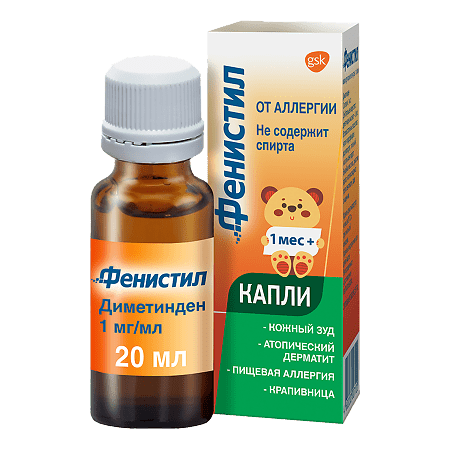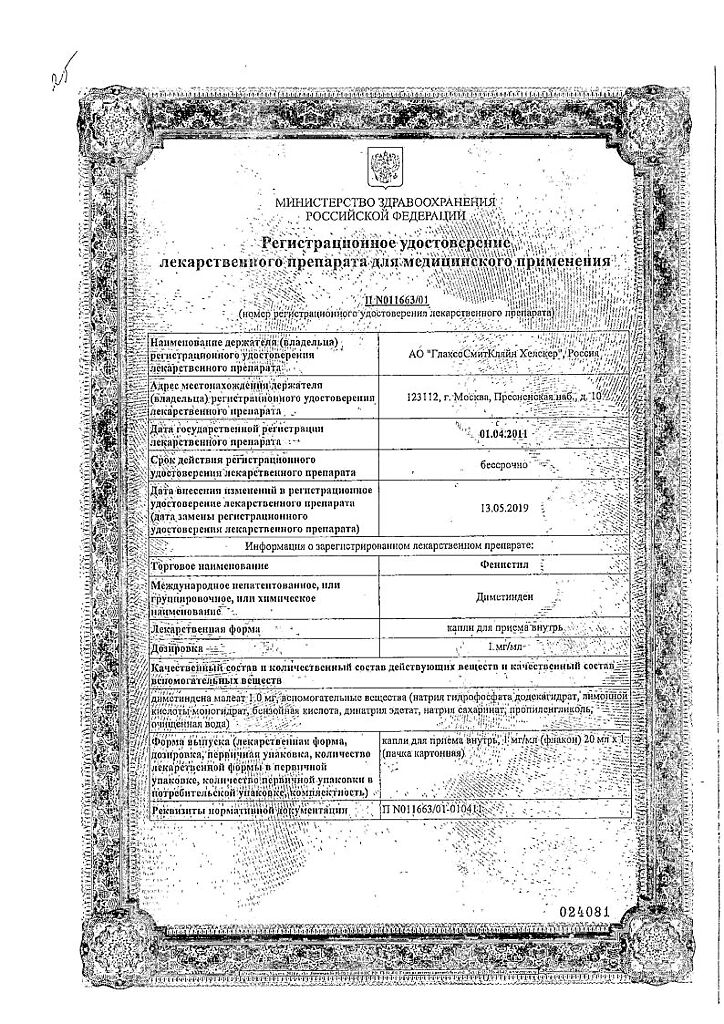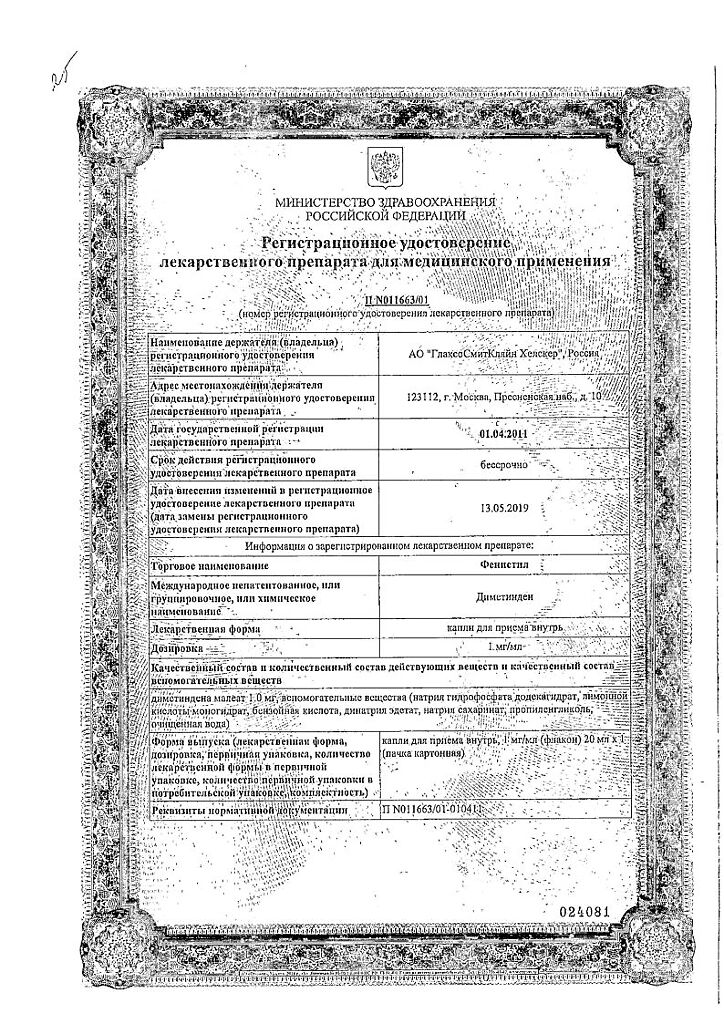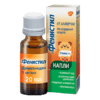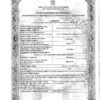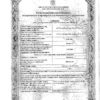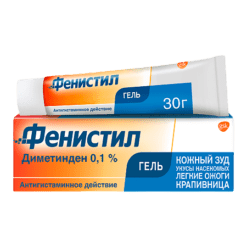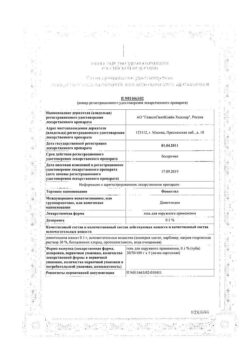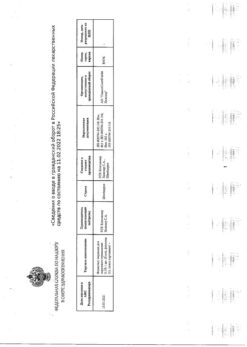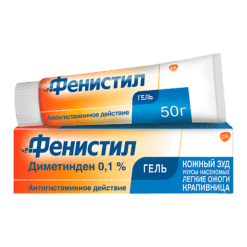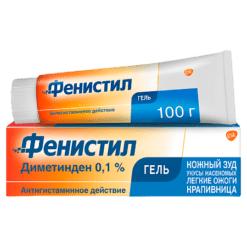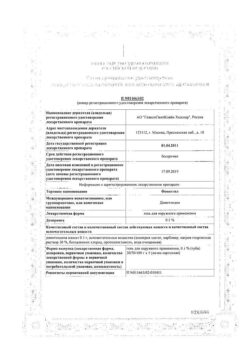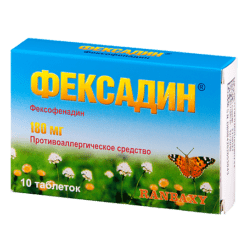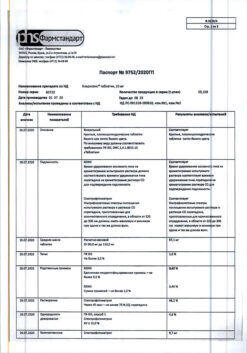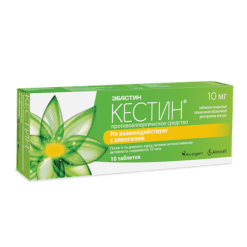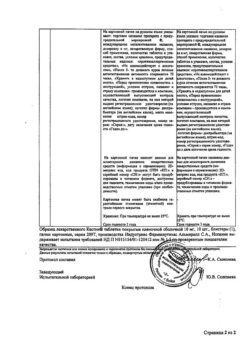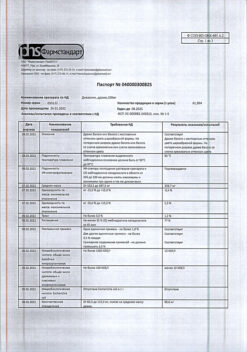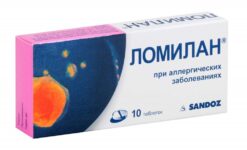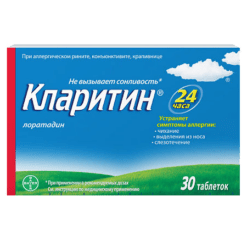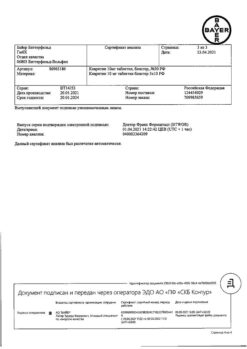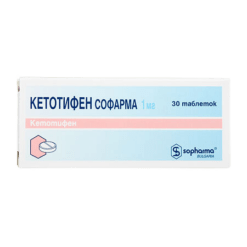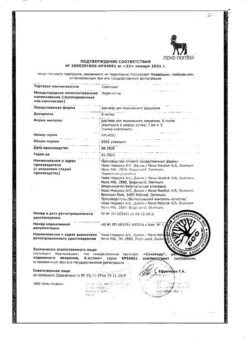No products in the cart.
Description
Pharmacological action – antihistamine, anti-allergic, antipruritic.
Pharmacodynamics
Antihistamine, anti-allergic and antipruritic agent. Blocker of H1-histamine receptors, is a competitive histamine antagonist.
The drug reduces increased capillary permeability associated with allergic reactions. It also has anti-bradykinin and weak m-cholin-blocking effects. A slight sedative effect may be noted when taking the drug in the daytime.
Pharmacokinetics
It is quickly and completely absorbed when taken orally.
The bioavailability is about 70%.
The Tmax of dimethindene in plasma after oral administration of drops is 2 hours. Binding with plasma proteins is 90%. It penetrates into the tissues well. Metabolized in the liver through hydroxylation and methoxylation. T1/2 is 6 hours. It is excreted in the bile and urine (90% – as metabolite and 10% – unchanged).
Indications
Indications
Allergic diseases: urticaria, hay fever, perennial allergic rhinitis, angioedema, food or drug allergies.
– Skin itching of various origins: eczema, itchy dermatoses, including atopic dermatitis, measles, rubella, chicken pox, insect bites.
– Prevention of allergic reactions during hyposensitizing therapy.
Pharmacological effect
Pharmacological effect
Dimetindene is a competitive inhibitor of histamine at H1 receptors. At low concentrations, it stimulates histamine methyltransferase, leading to histamine deactivation. It has a strong affinity for H1 receptors and is a strong mast cell stabilizer. Has local anesthetic activity. Does not affect H2 receptors. Dimetindene also acts as an antagonist of bradykinin, serotonin and acetylcholine. Dimetindene is a racemic mixture that includes R-(-)- dimethindene, which has greater H1-antihistamine activity; it significantly reduces the increased capillary permeability associated with allergic reactions. When used in conjunction with H2-antihistamines, dimethindene maleate almost completely suppresses all hemodynamic effects of histamine
Antihistamine, antiallergic and antipruritic agent. Dimetindene is effective in the systemic treatment of allergic and pseudoallergic conditions, as well as other diseases associated with the release of histamine (for example, itching of various origins, prevention of histamine-related anaphylactic reactions caused by anesthesia or the use of histamine-releasing drugs, or insect bites). The initial response after taking the drug is expected within 30 minutes, the maximum response is expected within 5 hours. The effect of the drug on skin reactions after taking 4 mg of dimethindene as a separate dose is expected up to 24 hours after administration.
Special instructions
Special instructions
The drug is ineffective for itching associated with cholestasis. Fenistil drops should not be exposed to high temperatures.
When administered to infants, they should be added to a bottle of warm baby food immediately before feeding. If the child is already being spoon-fed, the drops can be given undiluted. The drops have a pleasant taste.
The drug should be used with caution in children from 1 month to 1 year due to the fact that the sedative effect may be accompanied by episodes of sleep apnea. In this group of patients, the use of the drug is recommended after consultation with a doctor and only for medical reasons requiring treatment with antihistamines.
In young children, particularly those under 6 years of age, antihistamines may cause increased excitability.
The drug should be used with caution in elderly patients due to the increased likelihood of adverse reactions such as excitability and fatigue.
The use of the drug is contraindicated in elderly patients suffering from confusion. The use of the drug in elderly patients is recommended after consultation with a doctor.
Active ingredient
Active ingredient
Dimetinden
Composition
Composition
Composition per 1 ml:
Active ingredient mg: Dimetindene maleate 1.0
Excipients: Sodium hydrogen phosphate dodecahydrate 16.0 Citric acid monohydrate 5.0 Benzoic acid 1.0 Disodium edetate 1.0 Sodium saccharinate 0.5 Propylene glycol 100.0 Purified water 888.5
Pregnancy
Pregnancy
Fertility
There is insufficient data on the effect of dimethindene maleate on the reproductive function of women. In animal studies, no effect of the drug on fertility was observed, however, caution should be exercised when prescribing the drug to patients planning a pregnancy.
Pregnancy
Before using the drug, you should consult your doctor! There is insufficient clinical data on the use of dimethindene maleate during pregnancy. Animal studies have not shown direct or indirect negative effects on pregnancy or fetal/newborn health. The use of the drug during pregnancy is not recommended, except in cases where the benefit to the mother outweighs the potential risk to the fetus and only under medical supervision.
Breastfeeding period
It is believed that dimethindene maleate may be excreted in breast milk. The drug is not recommended for use during breastfeeding.
Contraindications
Contraindications
– Hypersensitivity to the components of the drug.
– Children up to 1 month of age, especially in premature patients.
– Breastfeeding period.
– Angle-closure glaucoma.
– Bronchial asthma.
– Prostatic hyperplasia.
– Use in elderly patients suffering from confusion.
Side Effects
Side Effects
Adverse reactions are classified according to body systems and according to the frequency of development. The frequency of adverse reactions is determined as follows: very common (≥ 1/10), common (≥ 1/100 and < 1/10), uncommon (≥ 1/1000 and < 1/100), rare (≥ 1/10,000 and < 1/1000), very rare (< 10,000), frequency unknown (frequency cannot be estimated based on available data). data).
Immune system disorders: Very rare: anaphylactoid reactions including facial swelling, pharyngeal swelling, rash, muscle cramps and shortness of breath.
Mental disorders: Rare: anxiety.
Nervous system disorders: Very common: fatigue. Often: drowsiness, nervousness. Rarely: headache, dizziness. Gastrointestinal disorders: Rare: gastrointestinal disorders, nausea, dry mouth, dry larynx.
If any of the side effects indicated in the instructions get worse, or you notice any other side effects not listed in the instructions, tell your doctor.
Interaction
Interaction
The combined use of two or more drugs that depress the function of the central nervous system increases the depression of the central nervous system, which can lead to undesirable and even life-threatening consequences. Thus, the combined use of the drug and opioid analgesics, anticonvulsants, tricyclic antidepressants, MAO inhibitors, antihistamines, antiemetics, neuroleptics, anxiolytics, hypnotics, scopolamine, ethanol is not recommended. Tricyclic antidepressants and m-choline blockers (bronchodilators, gastrointestinal antispasmodics, drops to dilate pupils, etc.) increase the antimuscarinic effect and increase the risk of exacerbation of glaucoma or urinary retention. It is also necessary to avoid the combined use of antihistamines and procarbazine to reduce the effect of depression of central nervous system functions and possible potentiation.
Overdose
Overdose
Symptoms
Central nervous system (CNS) depression and drowsiness (mainly in adults), CNS stimulation and m-choline blocking effects (especially in children and elderly patients), incl. agitation, ataxia, tachycardia, hallucinations, tonic-clonic convulsions, mydriasis, dry mouth, flushing of the face, urinary retention, fever, decreased blood pressure, collapse and coma.
Treatment
Activated carbon, saline laxatives, medications to support the functioning of the cardiac and respiratory systems (analeptics should not be used).
Clinical pharmacology
Clinical pharmacology
Suction
It is quickly and completely absorbed when taken orally. The systemic bioavailability of the drug is approximately 70%. The maximum serum concentration of dimethindene is achieved within 2 hours after administration.
Distribution
At concentrations in the range of 0.09–2 μg/ml, the binding to plasma proteins is 90%.
Metabolism
Metabolic reactions include hydroxylation and methoxylation of dimethindene.
Removal
The half-life of the drug is about 6 hours. Dimetindene and its metabolites are excreted by the liver or kidneys (90% as metabolites and 10% unchanged).
Short product description
Short product description
Fenistil drops for oral administration are an oral antihistamine that relieves the symptoms of skin rashes, reduces itching and irritation from insect bites and allergic skin reactions.* Once ingested, the drops begin to work within 30 minutes after use.*
Advantages* Fenistil drops:
– suitable for adults and children from 1 month of age,
– do not contain alcohol or dyes
– provide ease of dosing.
* Instructions for medical use, RU No P-011663/01 dated 05/13/2019
Recommendations for use
Recommendations for use
For oral administration. Do not exceed the recommended dose!
The maximum duration of use of the drug without consulting a doctor is 7 days.
20 drops of the drug correspond to 1 ml of the drug or 1 mg of dimethindene.
Children aged 1 month to 12 years: the recommended daily dose is 0.1 mg/kg body weight, which is equivalent to 2 drops per kg body weight. The daily dose should be divided into 3 doses.
Children aged 1 month to 1 year should take the drug only as prescribed by a doctor and if there are indications for the use of H1-histamine receptor blockers.
Children over 12 years of age and adults: the recommended daily dose is 3–6 mg of dimethindene (60–120 drops), divided into 3 doses, that is, 20–40 drops 3 times a day.
Special patient groups
For elderly patients (over 65 years of age), no dose adjustment is required. For patients prone to drowsiness, it is recommended to use 40 drops before bedtime and 20 drops in the morning.
Storage conditions
Storage conditions
Store at a temperature not exceeding 25°C in the original packaging.
Keep out of the reach of children.
Shelf life
Shelf life
2 years.
Manufacturer
Manufacturer
GSK Consumer Healthcare S.A., Switzerland
Additional information
| Shelf life | 2 years. |
|---|---|
| Conditions of storage | The drug should be kept out of reach of children, in the original package, at a temperature not exceeding 25°C. |
| Manufacturer | GSC Consumer Healthcare S.A., Switzerland |
| Medication form | oral drops |
| Brand | GSC Consumer Healthcare S.A. |
Other forms…
Related products
Buy Phenystil, drops 1 mg/ml 20 ml with delivery to USA, UK, Europe and over 120 other countries.

